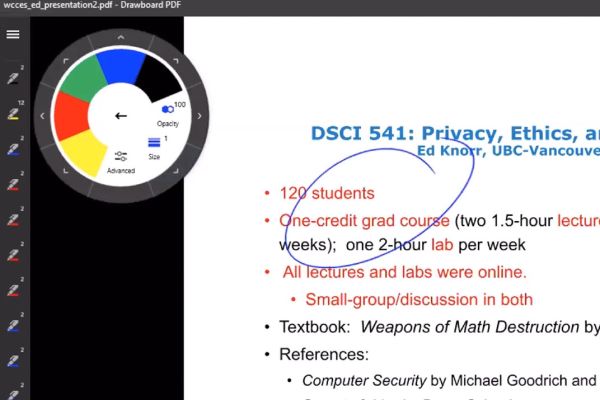
Teaching online teaches resourcefulness
When COVID-19 restrictions entered our lives, educational institutions everywhere had to pivot quickly to figure out how they would teach successfully online. And the UBC Department of Computer Science was no exception.
How do you deliver an engaging lecture online to hundreds of students? How do you run labs so everyone is participating, and gets the individual attention they need? How do you interact effectively and efficiently? All extremely important questions.
UBC CS professors sought tools and tactics they hoped would help. Some proved to be useful. Some did not. But like anything new, trial and error allows for learnings and improvements, and eventually—success. Senior Instructor Ed Knorr in the department shared some of his favourite tools that have encouraged interactivity and engagement with students:
- Blackboard Collaborative Ultra He, and his Teaching Fellow Firas Moosvi, used this to deliver labs, lectures and office hour visits for a data science course. The popular video-conferencing software allows one to teach courses online, engage students, and manage courses and information.
- Drawboard This inexpensive and robust tool allows you to write or draw on any PDF document online and post it for later viewing.
- Sli.do This software allows you to create and issue polls for added engagement.
Alongside the tools, Ed and Firas employ tactics like:
- Having Firas co-host sessions, so that Firas can keep an eye on the chatrooms and help with technical problems while Ed teaches
- Recording ALL lectures and posting them, for students who can’t attend real time
- Making all assignments, quizzes and lab write-ups due on the weekend, rather than having different due dates throughout the week
- Creating breakout rooms in both the lectures and the labs. The course had a lot of case studies that are moderated by TAs and selected student volunteers, while Ed and Firas ‘roam’ the breakout rooms to ensure that conversations keep flowing, and ask questions to prompt further discussion. Chat sessions and polls were also used within a breakout room.
Sessional instructor Felix Grund, who was teaching CPSC 210 (Software Construction) last term, made similar efforts to ensure his lectures were more interactive. Felix employed tactics like:
- Asking students to present their solutions via screen sharing
- Having students create branches and pull requests with their solutions on Github
- Using AWWAPP – A Web Whiteboard to draw with students interactively
“These tools were successful in keeping interaction going rather than just me, teaching ‘old-school lecture style’ said Felix.
The profs aren’t the only ones seeking a more gratifying and seamless online experience. Senior Instructor Cinda Heeren is currently teaching a double-speed summer term, with 184 students. One day before class, in the online chat window, a student suggested they should have intro music playing. After class, another student debugged the process of sharing his audio, and the TA shared a Spotify playlist to which students could add tunes.
“When I got to the next open session, Daft Punk was playing! After the online class session finished, the student DJ played Queen’s ‘Don’t Stop Me Now’ which was perfect for motivating the students just before they were about to take an exam,” said Cinda. “This was all organic and not my idea, but wow, it really makes for a nice vibe.”
It seems that during this COVID-19 situation, mixing the right software tools and a little ingenuity can make online learning more enjoyable.